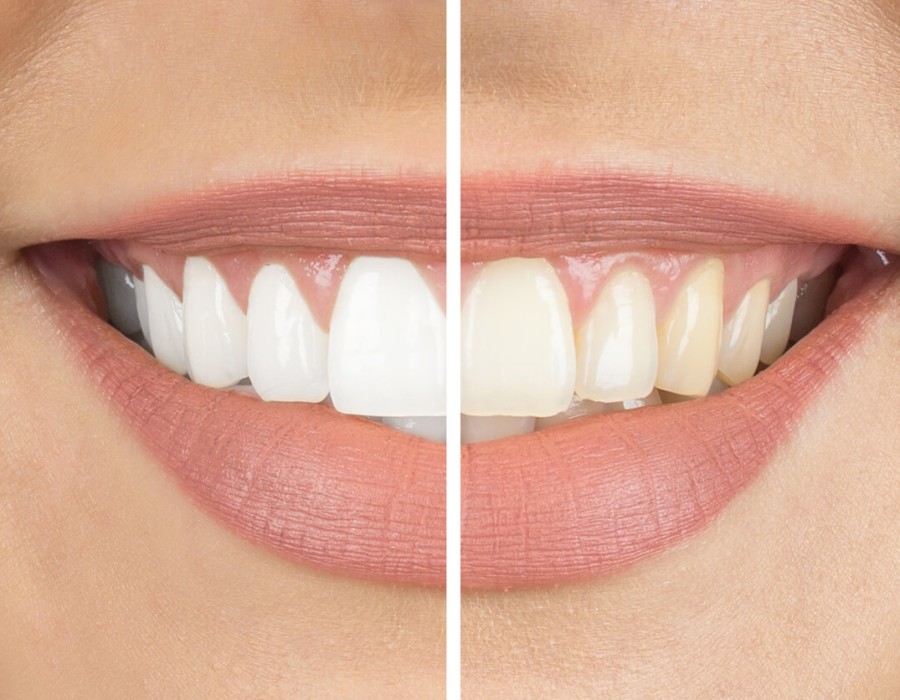Many people wonder, how does teeth whitening work? Teeth whitening is a popular cosmetic dental procedure designed to lighten the color of your teeth and remove stains or discoloration. Understanding the science and process behind Teeth Whitening can help you choose the best method for a brighter, more confident smile.
The Science Behind Teeth Whitening:
Teeth whitening primarily involves breaking down stains on the enamel and dentin layers of your teeth.
- Whitening agents usually contain hydrogen peroxide or carbamide peroxide as the active ingredient
- These peroxide compounds penetrate the tooth surface and release oxygen molecules
- Oxygen molecules react with stain molecules, breaking the chemical bonds causing discoloration
- This chemical reaction lightens the color of the teeth by removing yellow, brown, or gray stains
- Whitening can target both extrinsic stains (surface) and intrinsic stains (inside the tooth)
- The strength and duration of exposure affect how much whitening occurs
This oxidation process is what makes teeth appear visibly whiter.
Types of Teeth Whitening Methods:
Several methods are available depending on the desired results, convenience, and budget.
- In-office whitening: Professional treatment with high-concentration peroxide and light or laser activation for rapid results
- At-home whitening kits: Custom or over-the-counter trays with lower peroxide concentration used over several days or weeks
- Whitening toothpaste: Contains mild abrasives and low levels of peroxide for gradual stain removal
- Whitening strips: Flexible strips coated with peroxide gel applied directly to teeth for short periods
- Natural remedies: Options like baking soda or activated charcoal offer mild whitening effects but less predictable results
- Combination treatments: Using in-office procedures followed by at-home maintenance for longer-lasting effects
Each method varies in cost, convenience, and effectiveness.
How Long Does Teeth Whitening Last?
The longevity of teeth whitening results depends on several factors.
- Lifestyle choices like smoking or drinking coffee, tea, or red wine can cause re-staining
- Good oral hygiene slows down the return of discoloration
- Some people may need touch-up treatments every 6 to 12 months
- The depth and type of original stains affect how long whitening lasts
- Using whitening toothpaste or periodic at-home treatments helps maintain brightness
- Professional cleanings by your dentist can extend the effects
Being mindful of these factors helps you enjoy a bright smile longer.
Safety and Side Effects of Teeth Whitening:
While generally safe, teeth whitening has some potential side effects and precautions.
- Tooth sensitivity is common during or after treatment, usually temporary
- Gum irritation can occur if whitening agents contact soft tissues
- Overuse of whitening products can damage enamel and cause uneven results
- Pregnant or breastfeeding women should consult their dentist before whitening
- People with dental restorations like crowns or veneers may see uneven whitening
- Always follow product instructions and seek professional advice if unsure
Choosing safe whitening options minimizes risks and protects your oral health.
Tips for Effective Teeth Whitening:
Maximize the benefits of Teeth Whitening Treatment with these helpful tips.
- Consult your dentist before starting any whitening treatment
- Avoid foods and drinks that stain immediately after whitening sessions
- Maintain regular brushing and flossing routines
- Use recommended whitening products that suit your dental needs
- Consider professional whitening for more stubborn stains or quick results
- Protect your teeth from further staining with a healthy diet and habits
Following these tips helps you achieve and maintain a bright, healthy smile.





Comments